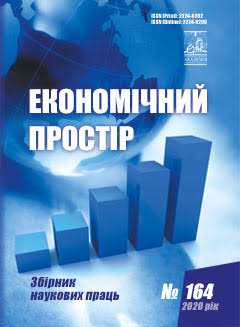METHODOLOGICAL TOOLS FOR THE STUDY OF INTERNATIONAL LABOR MIGRATION IN THE CONDITIONS OF GLOBALIZATION
Abstract
The current dynamic conditions of the global economic environment require countries and regions to build and implement an effective socio-economic strategy, an integral part of which is the management of human resources and their migration. The purpose of this article is development of a methodology for systematic research of international migration of human resources in the context of socio-economic transformations and substantiation on this basis of new conceptual principles of diagnosis and regulation of migration processes of economically active population at the national, interstate and regional levels. A prerequisite for determining the areas of regulation of international migration of qualified personnel in the context of globalization is the study of migration flows and assessment of migratory attitudes of the population of the country or territory. Quantitative and qualitative methods are used in the study of migration processes. Quantitative methods allow us to identify patterns of development of the phenomenon and derive common features, while qualitative methods allow us to make a structural description and explain the dynamics of the process. In turn, the proposed system of determinants of the formation of migration motives made it possible to formalize and build a basic model of migration attractiveness of the country, which can be used for comparative analysis. In the study of migration processes, qualitative methods are used, which consist in the structural description of migration flows, and quantitative methods, which consist in the processing of statistical information and are based on the calculation of deterministic indicators. The influence of states on migration processes takes the form of regulating the quantitative and qualitative composition of migrants, protecting their rights and freedoms and can be carried out directly or indirectly, provided that institutional actors will form common tasks and implement them in accordance with the outlined areas of public policy.
References
Слюсаревський М.М., Блинова О.Є. Психологія міграції : навч. посіб. Національна академія педагогічних наук України, Інститут соціальної та політичної психології. Кіровоград : ТОВ «Імекс ЛТД», 2013. 244 с.
Корель И., Корель Л. Миграционные и макроэкономические процессы в постсоциалистической России: региональный аспект. РПЭИ, Фонд Евразия, 1999. 81 с.
Осипенкова О.Ю. Миграционные процессы: методы моделирования и прогнозирования (на примере Московской области). Вестник Екатерининского института. 2016. № 3 (35). С. 79–85.
Ярошевич М. Прогноз міграції між ЄС, країнами Вишеградської четвірки та Східною Європою: наслідки скасування візового режиму. Центр східних досліджень. Варшава. Польща, 2014. 184 с.
Esipova N., Pugliese A., Ray J. Potential net migration index declines in many countries. GALLUP. Washington, D. C., 2014. URL: http://news.gallup.com/poll/166796/potentialnet-migration-index-declines-countries.aspx?utm_%20source=PNMI&utm_medium=search&utm_campaign=tiles (дата звернення: 20.10.2020).
Zipf G. Human behaviour and the principle of least effort. Addison-Wesley Press. Cambridge, Mass., 1949. 573 p.
Stouffer S. Intervening opportunities and competing migrants. Journal of regional science. 1960. Vol. 2, Issue 1. P. 26.
Lee E. A Theory of Migration. Demography, 1966. № 3(1). P. 47–57.
Migration Conceptual Framework: Why do people move to work in another place or country? AAG Center for Global Geography Education. 2011. P. 12. URL: http://cgge.aag.org/Migration1e/ConceptualFramework_Jan10/ConceptualFramework_Jan105.html (дата звернення: 20.10.2020).
П’ятковська О.Р. Механізми регулювання міжнародної трудової міграції: визначення операційного поняття. Глобальні та національні проблеми економіки. 2015. Вип. 8. С. 66–70.
Ваврищук Н.Г. Міжнародна міграція робочої сили в контексті розширення Європейського Союзу : автореф. дис. … канд. екон. наук : 08.00.02. Київ, 2007. 20 с.
Стаканов Р.Д. Вплив трудової еміграції на макроекономічний розвиток України : автореф. дис. … канд. екон. наук : 08.00.02. Київ, 2010. 20 с.
Ратникова Т.А. Введение в эконометрический анализ панельных данных. Экономический журнал ВШЭ. 2006. № 2. С. 267–316.
Sliusarevskyi M.M., Blynova O.Ye. (2013) Psykholohiia mihratsii [Psychology of migration]. Kirovohrad : TOV «Imeks LTD». (in Ukrainian)
Korel' I., Korel' L. (1999) Migracionnye i makrojekonomicheskie processy v postsocialisticheskoj Rossii: regional'nyj aspekt [Migration and macroeconomic processes in post-socialist russia: regional aspect]. RPJeI, Fond Evrazija. (in Russian)
Osipenkova O.Ju. (2016) Migracionnye processy: metody modelirovanija i prognozirovanija (na primere Moskovskoj oblasti) [Migratory processes: methods of modeling and forecasting (on the example of the Moscow region)]. Vestnik Ekaterininskogo instituta. vol. 3 (35). pp. 79–85.
Yaroshevych M. (2014) Prohnoz mihratsii mizh YeS, krainamy Vyshehradskoi chetvirky ta Skhidnoiu Yevropoiu: naslidky skasuvannia vizovoho rezhymu [Forecast of migration between the EU, the Visegrad Four and Eastern Europe: the consequences of the abolition of the visa regime]. Tsentr skhidnykh doslidzhen. Varshava. Polshcha.
Piatkovska O.R. (2015) Mekhanizmy rehuliuvannia mizhnarodnoi trudovoi mihratsii: vyznachennia operatsiinoho poniattia. Global and National Problems of Economy. vol. 8. pp. 66–70. (in Ukrainian)
Esipova N., Pugliese A., Ray J. (2014) Potential net migration index declines in many countries. GALLUP. Washington, D. C. Available at: http://news.gallup.com/poll/166796/potentialnet-migration-index-declines-countries.aspx?utm_%20source=PNMI&utm_medium=search&utm_campaign=tiles (accessed: 20.10.2020).
Zipf G. (1949) Human behaviour and the principle of least effort. Addison-Wesley Press. Cambridge, Mass.
Stouffer S. (1960) Intervening opportunities and competing migrants. Journal of regional science. Vol. 2, Issue 1. p. 26.
Lee E. A (1966) Theory of Migration. Demography. Vol. 3 (1). pp. 47–57.
Migration Conceptual Framework: Why do people move to work in another place or country? AAG Center for Global Geography Education. Available at: http://cgge.aag.org/Migration1e/ConceptualFramework_Jan10/ConceptualFramework_Jan105.html (accessed: 20.10.2020).
Vavryshchuk N.H. (2007) Mizhnarodna mihratsiia robochoi syly v konteksti rozshyrennia Yevropeiskoho Soiuzu [International labor migration in the context of the enlargement of the European Union]: (PhD Thesis), Kyiv: National University of «Kyiv-Mohyla Academy».
Stakanov R.D. (2010) Vplyv trudovoi emihratsii na makroekonomichnyi rozvytok Ukrainy [The impact of labor emigration on the macroeconomic development of Ukraine]: (PhD Thesis), Kyiv : Taras Shevchenko National University of Kyiv.
Ratnikova T.A. (2006) Vvedenie v jekonometricheskij analiz panel'nyh dannyh [Introduction to Econometric Analysis of Panel Data]. The HSE Economic Journal. no 2. pp. 267–316.



